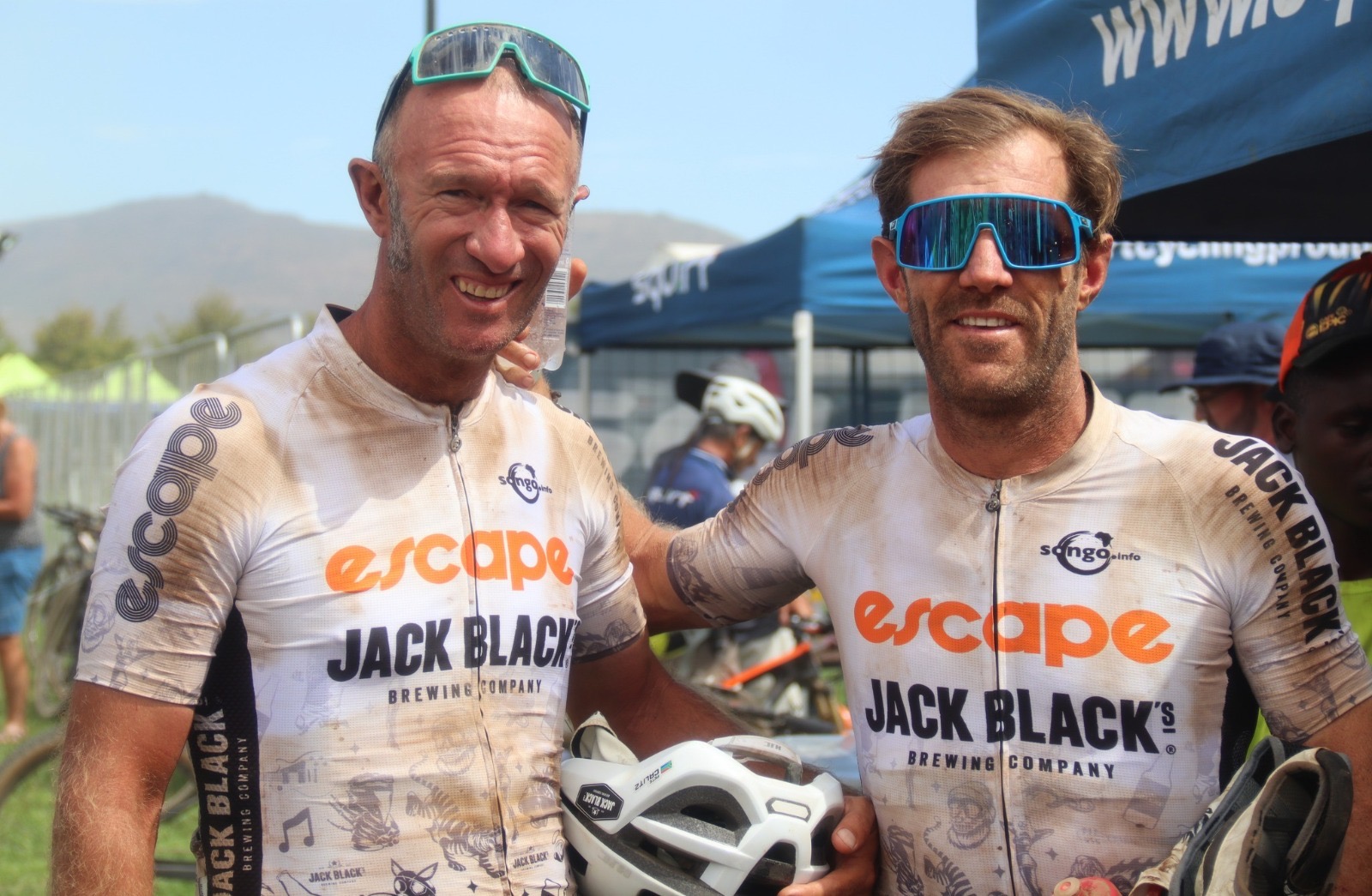Escape members Nic Lamond and Pete Calitz recently represented Escape at the 2024 Cape Epic, the toughest mountain bike race in the world. This is the story of their ride , as told by Nic, and an event that has a special place in the heart of many cyclists, us included.
Intro
South Africa’s Absa Cape Epic is a call to adventure, a hero’s journey for every single rider – pro and amateur, seasoned vet or ‘newbie’. It’s a grand expedition in a hostile land, where the outside world melts away and you’re forced to confront your why. Increasingly, I realise these stories are a large part of why I’m drawn to this race.
The intensity of the Epic experience is on two levels. It’s a serious physical challenge that you underestimate at your peril. And you are continuously brought face to face with your emotional and mental landscape, and your riding partner’s. This constant introspection takes even the fittest riders by surprise. After a month of processing the physical and mental overload of the 2024 Cape Epic in March this year, this is my story.
***
Sacrifice, skill, readiness. Conquer the Prologue and your prize is seven brutal days of regrouping, ritualising your pre-dawn preparation, and rolling over the start line at the mercy of route designers and Africa’s untamed elements.
This is the Cape Epic. The pinnacle of mountain bike stage racing. Held in South Africa’s Western Cape region over eight days in March each year. It will be tough, the Cape Epic always is, and there’s no guarantee what story you will tell. Will it be one of triumph through adversity? Of wonder at the overwhelming beauty of this land? Of split-second decisions that ended it all? Of teamwork? Of gratitude? Of circumstances that made continuing impossible?
2024 was the 20th edition of “the untamed African mountain bike stage race”. 603 km with 16,050 metres of vertical ascent. Although it was the shortest edition of the race, this one had the most climbing per kilometre. It was my 12th Cape Epic and yet, as the commissaire called us to the dais and counted us down, a kaleidoscope of butterflies gathered in my stomach as if it was my first.
A quick look across the excited crowd. A fist-bump with my partner. Three, two, one, go! Clip into the pedals. Two pedal strokes down the wooden incline and the lush grass instantly sapped our momentum. Family and friends’ cheers rung in our ears. The announcer called our names. The live video stream focused on our slick new kit. We felt under pressure to stand. Out of the saddle. Under the start-finish banner. Hard left. Hard right. Working against the thick lawn. Another right turn under a bridge with the crowd fading behind us and we were finally free of the field. Out of sight. Sit down. Phew. That was embarrassingly hard.

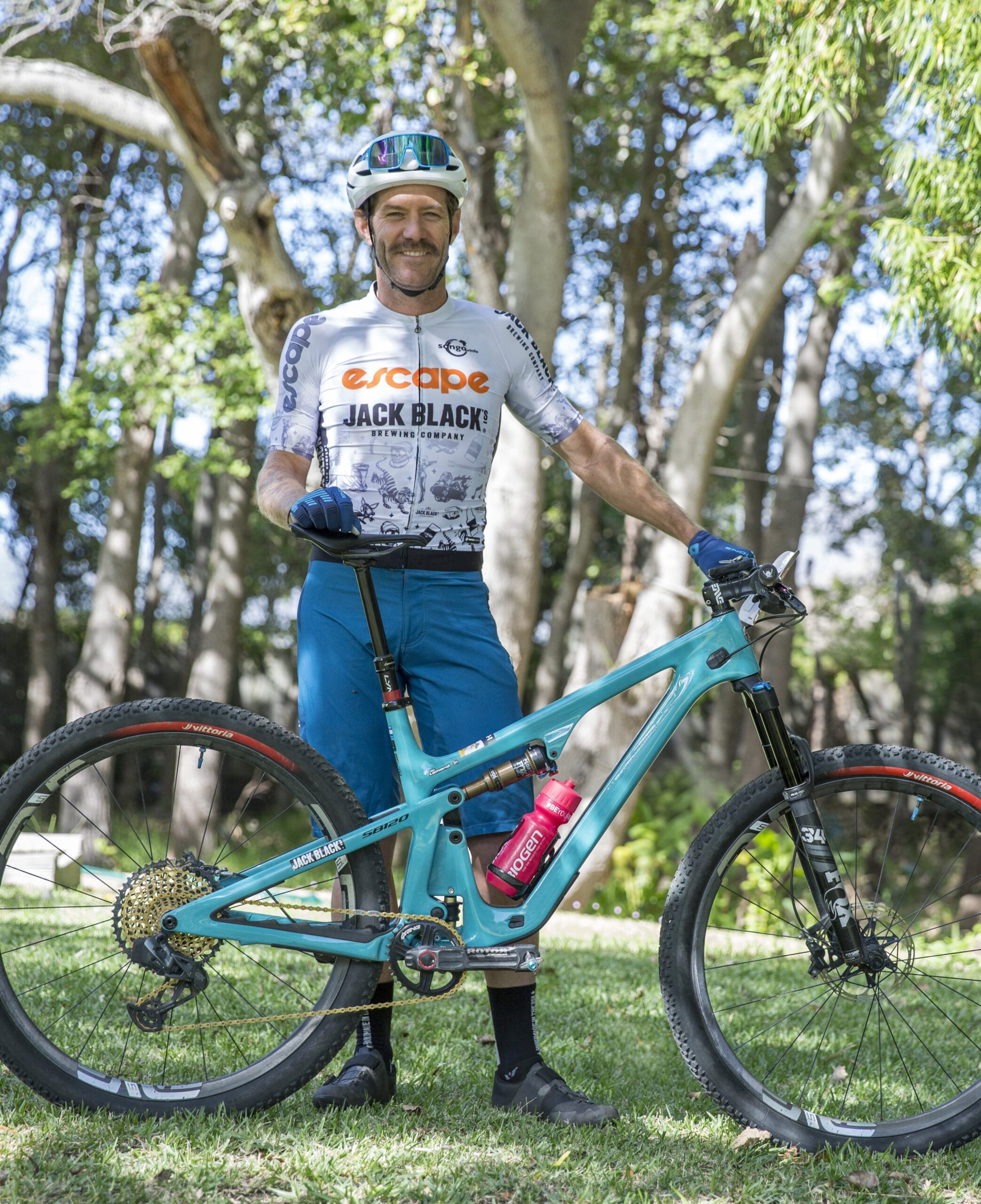
Partnership
I glanced across at my partner, my mate, Pete Calitz, as I sat back in the saddle and was comforted to see him sweating too. Not even a kilometre into our 600 km odyssey and we were revving our engines way beyond the ‘easy’ tempo we’d agreed upon. Starting nerves, I told myself. We exchanged a few words and resolved to bring our heart rates down to navigate what remained of the 26 km route.
Pete is no stranger to the pressure of pinning on a race number. He’s seen more race start lines than most. This was his sixth Cape Epic and he had soldiered through his first five from 2010 to 2015, back when the race was longer, (slightly) flatter, with less technical terrain.
Pete’s exploits on local road and mountain bike trails in the 2010s are legendary. There are still plenty of Strava segments around Cape Town with his name at the top of the leaderboard. Since 2015, Pete had traded in fat tyres for trail shoes, becoming one of South Africa’s foremost veteran ultra-distance trail-runners. Pete is a tennis coach and spends hours on his feet daily. I was stoked to be sharing my Epic experience with one of the fittest 49-year-olds on the planet.
We have been chasing each other on bikes for years and shared countless beers along the way, not only at bike events, but in celebrating new years, old mates, weddings, fatherhood, life. I’d floated the idea of riding the Epic with Pete in May 2023. Firstly, I got permission from his pregnant wife, Thea, and then I approached Pete himself.
When we actually got confirmation of our Escape Collective media entry for the Epic, it was January 16, eight months after we first thought about it. Two months to race day on March 17. Thankfully, both Pete and Thea were still game despite the arrival of their firstborn, Van, four months earlier. The question now was how to approach it and what could we hope to achieve with such a short runway?
With so little time to train, it was clear that we were going to be leaning heavily on our experience.
Expectations
First step: don’t panic. I took on the role of coach. The day we confirmed our entry I found an old 16-week, heart rate-based training program from a past Epic, chopped out the first eight weeks we didn’t have anymore, adjusted it for Van’s sleeping habits (or lack thereof!), added a three-day music festival we’d already signed up for, and sent it off to Pete. We got stuck in straight away.
We hustled a ‘team meeting’ over beers and decided with an eight-week build-up we couldn’t impact the Masters category (both riders over 40) and keep our day jobs and families intact. We are at the shady end of that Masters category – I am 46 and Pete turned 49 in February. We weren’t looking for excuses, but the Cape Epic is notoriously tough to finish and apart from securing a trusted and compatible partner, having realistic and aligned expectations as a team is the most critical element to get ‘right’.
The emphasis for the race itself would be fun. To make it fun later, we were going to hurt in the short term. We got stuck into the least-fun training technique I knew – high-intensity intervals. The fact remained that hopeful Epic teams all around us had been hammering their road and mountain bikes, recce’ing sections of the route, planning their nutrition, designing their kit and tweaking their bikes for months already. Months we didn’t have. The amateur Epic field is incredibly deep, filled with hopeful riders taking it very seriously. Most critically, they’d had reason to lay off the Christmas food and booze excess. We had not.
By the time we hit the Prologue start, I had managed 36 rides, including a few local races, from mid-January to mid-March, for a total of 1,691 training kilometres over 78 hours. Less than 10 hours a week. Pete’s stats were similar. It wasn’t enough, but it was something.
By way of comparison I checked in with John Wakefield – coach to one half of the eventual 2024 Cape Epic-winning men’s team, Matt Beers – after the event. Naturally, he had started his Epic training long before January 16, 2024. However, over the same period (16 January to 16 March) he had put in 186 hours. Incredibly, Matt covered 4,856 km, almost three times our total distance! That’s what it takes.
What we lacked in saddle time we made up for with our deep understanding of each other’s strengths and weaknesses. We knew our partnership was going to be our secret weapon in a successful race. We also had experience. I had chosen my Cape Epic partner wisely 10 months earlier and now that this was actually happening, as the Epic approached with frightening speed, I was certain Pete was my guy.
We are both competitive by nature but not obsessive. We aren’t afraid of suffering. We also believe that fast is fun. The Epic demands respect but we resolved not to take ourselves too seriously in the process. Staying healthy was another priority. As was spending time together in the build-up. If we got to the start line in one piece – and that was not a given – we were going to appreciate the privilege of riding eight days of world-class trails together. To keep things light and stay true to our mountain biking roots we decided to race in baggies and vowed to share an ice-cold beer at every single finish line. To keep the budget in check we also decided to sleep in the race village tents and wrench our own bikes.
In retrospect it was a masterstroke that we invited my 76-year-old, semi-retired dad, also Pete, to be our supporter-in-chief for the week. Words can’t describe the love I have for this man. A wise and wildly quirky presence in the chaos of stage-racing. Since there was no outside assistance allowed on course, our only expectation of Pete Senior was to put that ice-cold beer in our hands on the finish line every day. He took his job very seriously.
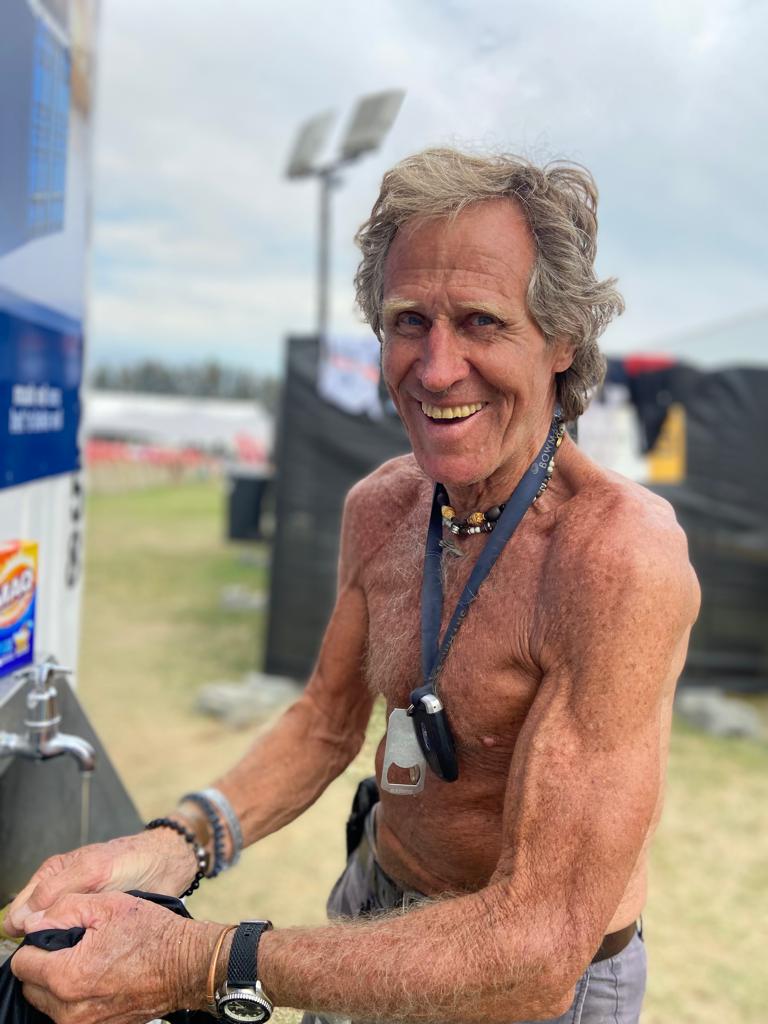
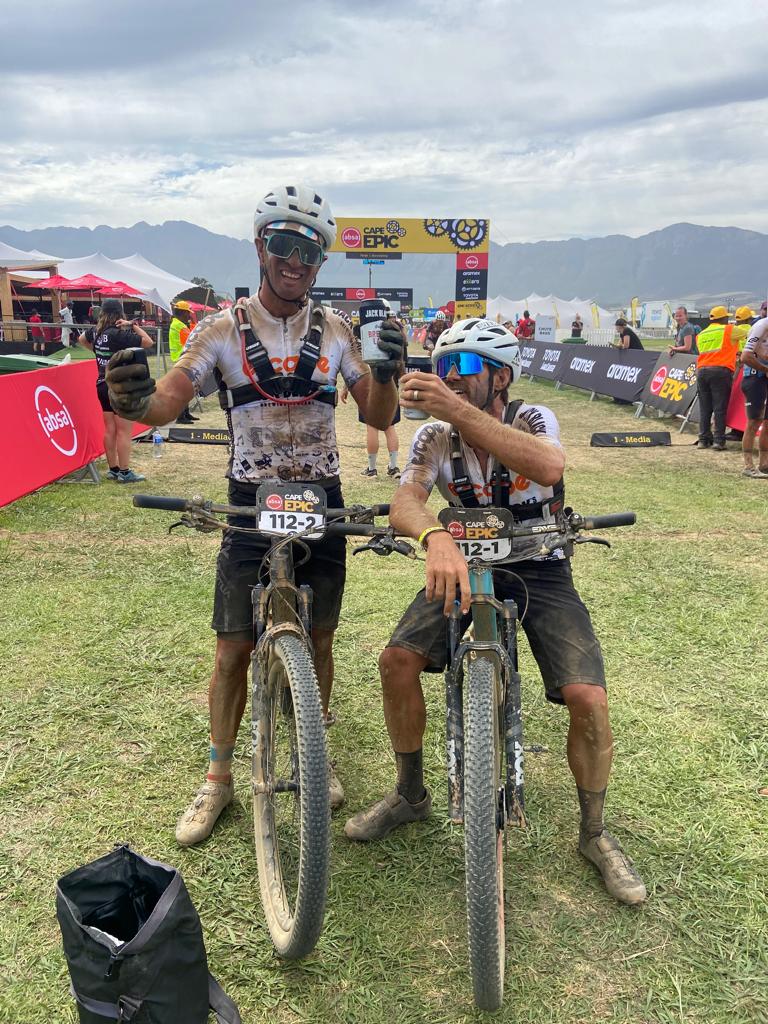
The rules
The Cape Epic is a team event, with riders pairing up to tackle the challenging route. Riders must remain within two minutes of their teammate at all times during the race or face a one-hour penalty. This is enforced via timing mats placed throughout the stage. After a third offence, the team is disqualified. There’s no outside assistance allowed, save for tech boxes for the pros to do their own running repairs and neutral mechanical help for the amateurs, at selected water points.
The two-person format adds a compelling twist to racing tactics at the pointy end of the field as pros try to isolate or attack the competition’s weaker team member to force an advantage. Further back in the bunch the partnership takes on a different dynamic as teams grapple with sometimes marked differences in skill, fitness, patience, and health, especially as the race wears on. Throw in crashes and mechanical dramas, which the harsh terrain serves up regularly, and otherwise strong teams can be limping along against the clock.
If a rider abandons the race the remaining partner can continue and, provided they complete each stage, will be recognized as an individual finisher. Any rider who bails or does not complete a stage within the maximum stage time can start the following day as a ‘blue board rider’, but they will not be classified as an official race finisher. Blue board riders can only do this once. Fail to make the daily cut-off twice and you’re out of the race.
The cost
The entry fee (it was R109,900 for South African citizens and US$7,800 for international riders in 2024) is just a softener for the real costs: flights, pre- and post-race accommodation, and any number of Epic ‘upgrade packages’ (mobile homes, off-site accommodation, bike maintenance, massage, nutrition, laundry services, photo packages), never mind the cost of race-ready bikes, pre-race maintenance, spares and other race entries incurred in preparation.
On a ‘cost-per-day’s riding’ almost any other stage race in the world is cheaper. If you are riding the Epic you are part of a wealthy elite or have sponsors with deep pockets. But reducing the Epic to the bare financial bones is missing its true value.
Prologue: Starting hard
26 km | 700 m
A month after crossing the final finish line in Stellenbosch, my Epic is still a blur. A (mostly) happy blur of bikes, heat, rocks, and banter. Looking over the route profiles conjures up vignettes of suffering, camaraderie, and joy in equal measure. It was a lifetime of emotion rolled into one intense eight-day experience.
After the adrenaline rush of the Prologue at Lourensford, Pete and I washed our bikes, ourselves and drove one and a half hours to Saronsberg, another wine estate. En route we debriefed our overzealous start.
I suffer from the red mist. If I hear a starter’s gun, I race. I had felt strong throughout the 26 km course and pushed the pace, working through slower teams and keeping it tidy in the technical sections. Our plan was solid. Stay within ourselves and stay on our bikes. The late summer sun and our midday start time had the mercury nudging 36 ºC (96.8 ºF) and had transformed any mud from Friday’s overnight showers into powder.
Pete took strain in the heat. The technical climbs to the day’s highest point required overtaking slower riders in insanely steep switchback berms. Keeping our heart rate down and continuing to pedal with no more gears left was impossible. We were forced into the red more than we wanted. I had gone deep, but not as deep as Pete. I was caught up in the excitement of it – the twisting, dusty trails were superb, the crowds were wild and we were on our Epic way.
“How hard was that?” I asked.
“I hit 174 bpm, which I haven’t seen in a very long time,” Pete laughed as we sped along in the car afterwards. “My average heart rate was 162 bpm, which was my peak doing our intervals a month ago!”
I laughed it off, knowing we had gone too hard in the Prologue, but expecting us to bounce back and find our rhythm as the real racing started. We were now ensconced in the Cape Epic bubble. The world around us disappeared and we were fully focused on trying to keep our gear organised in our tents, our recovery, and being primed for the next day’s racing.
Weirdly, as much as I love racing, I didn’t once check our finishing position. In years past I would be poring over the results sheet each day, making mental notes of who to chase and who to let go. I did none of that and I didn’t miss it.
Our time: 1:23 (21st in Masters, 127th overall)
Elite men’s winners: World Bicycle Relief (Nino Schurter/Sebastian Fini): 1:02
Elite women’s winners: Ghost Factory (Nicole Koller/Anne Terpstra): 1:14
Masters winners: Bulls Masters (Karl Platt/Tomas Misser): 1:10
Stage 1: Race rhythm
88 km | 2,450 m
Our Prologue effort landed us in B-batch for Monday’s stage 1 from Saronsberg and a frenetic bunch start. I went hard off the line again, ringing my handlebar-mounted bell (don’t laugh, a bell should be mandatory) to check Pete was still with me in the maelstrom.
We surfed the front of the peloton through the opening farmland flats as the sunrise pierced the rising golden dust. Then, suddenly, on an innocuous mound about 20 km in, I was suddenly pedaling fresh air. I looked down as my chain slipped through my derailleur into the dirt. We kept calm, pulled off the track, and spent the next eight minutes repairing a snapped chain while riders streamed past.
When we got going again we were deep in C-batch, stuck behind slower riders into the first serpentine singletrack climb. We tried a few frustrated overtaking manoeuvres but we didn’t make many places and only pissed off the riders around us. Not cool. So we settled in and rolled along with everyone else until the route eventually opened up an hour later.
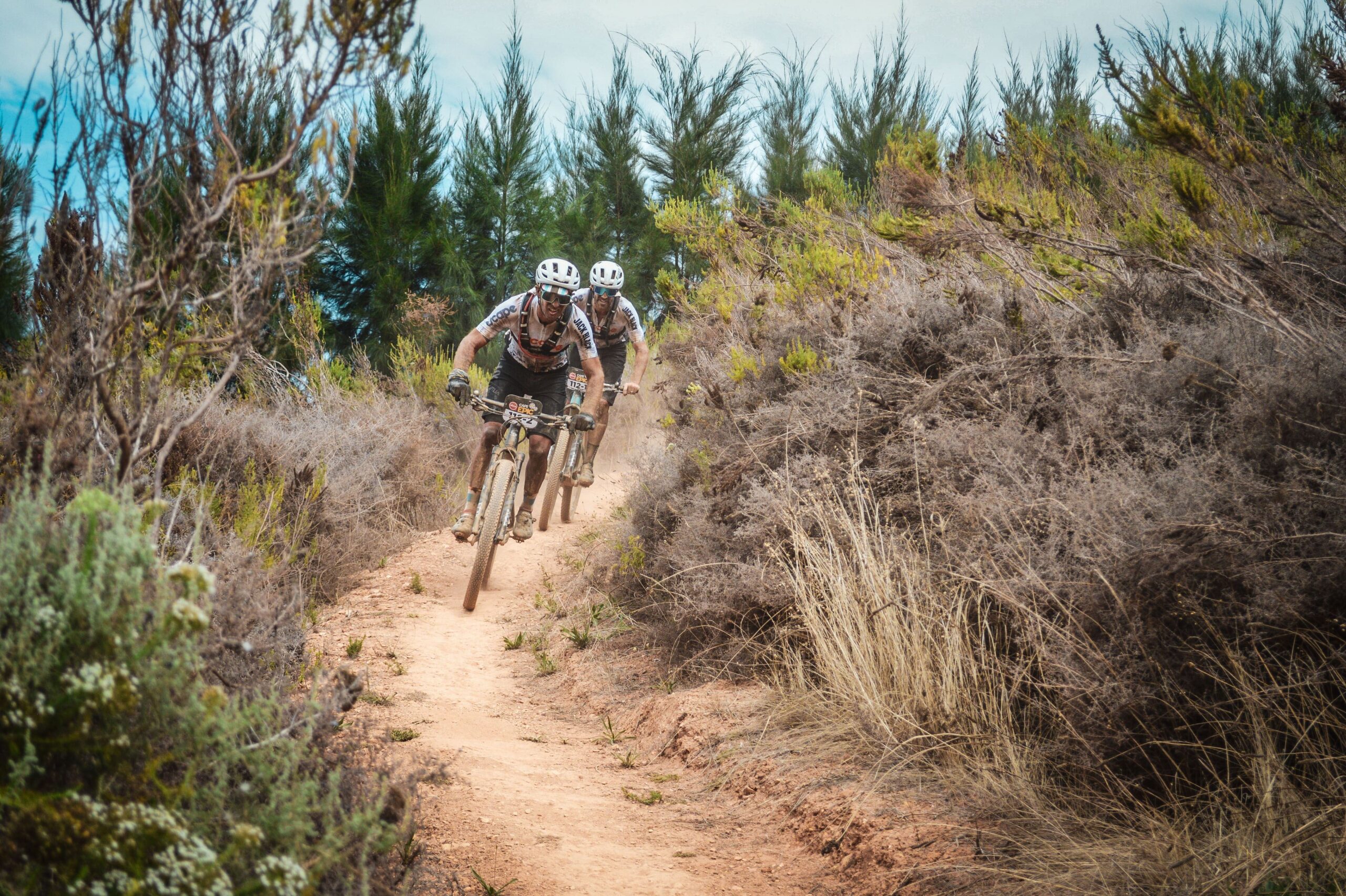
The sun was now as savage as the three climbs we faced in the final 30 km. The dust hung everywhere as we plodded up Kliprivier climb. Stunning singletrack descents didn’t fully return our stoke before the second climb, Jan se Bos, had us crawling skyward again. Two down. We knew we had to save something for the dreaded Fanti’s Pass. Looming at 70 km, we’d heard about the final excruciating climb of the day in hushed tones around the Saronsberg camp the previous night but little could prepare us for the reality: a loose 3 km jeep track with 25% gradient ramps.
I put my head down and ground out the first part of Fanti’s and paused for Pete. He wasn’t happy. I made some lame joke in an attempt to lighten the mood but he didn’t share my sense of humour, and grumbled past me shaking his head.
The day’s early intensity and our morning chase had caught up to him and we were in survival mode. We got a proper helping of humble pie as some of the riders in C-batch we’d been stuck behind on the first climb of the day passed us. Like a line of ants being tortured by a kid with a magnifying glass teams crawled up the precipitous pass under the harsh glare of the noonday sun. We were among the top 150-odd teams but very few were riding up here. I slowly edged past Pete and waited at the top.
Pete rode up to me cursing about not being able to clip into his pedals. He had walked a section of the pass and had a stone stuck in his cleat. He lifted his shoe so I could remove it and screamed in pain as his leg cramped up. I laughed out loud and quickly realised this wasn’t funny. Pete’s usual sunny outlook on life had abandoned him. He was not having fun anymore. We pushed on. A shaded indigenous forest traverse saved us – technical, raw, rocky, dusty and, mercifully, out of the sun’s harsh rays.
We crawled home in 176th position, 40th in Masters, a shade over five hours, grateful to be off the bike and out of the furnace. We were broken. After a beer, shower, endless water bottles and food, we crashed out on beanbags in the riders’ lounge in front of a huge fan spraying mist across the marquee. This would be our routine for the next six days: ride, eat, sleep, eat, sleep, eat, repeat.
A few hours later the race village was teeming with an army of staggering and sunburned riders. Pete looked fresh as a daisy by comparison. Almost 500 teams (1,000 riders!) had come in after us with some arriving just before dinner was served in the communal dining marquee at 6pm. They had been in the saddle for over eight hours and 20 minutes. 727 teams had rolled down the Prologue start chute. A day later 659 teams remained in the race.
Our time: 5:15 (40th in Masters, 176th overall)
Elite men’s winners: Buff Megamo (Hans Becking/Wout Alleman) 3:38
Elite women’s winners: Ghost Factory (Nicole Koller/Anne Terpstra) 4:25
Masters winners: Bulls Masters (Karl Platt/Tomas Misser) 4:02
Stage 2: The Wagon Trail
97km | 2200m
Our demotion to C-batch for stage 2 was the only reminder of our mechanical and physical explosion of the previous day. The thought crossed my mind that maybe we were C-batch riders who flew too close to the sun at the Prologue? Was B-batch our brief zenith and these C-batchers were our people? Only time would answer that question.
More heat was on the cards and Pete and I toned down our start, expecting a big day out.
The Wagon Trail was the big test of stage 2 in both directions because the route doubled back on itself. The trail is 8 km of vertiginous singletrack, and we hit it 10 km into the stage. Riders caught wanting in technical rocky bottlenecks forced everyone behind them to dismount. Pete and I tried staying upright, trackstanding to prove a point. A few riders let us through when they realised we were still pedalling as they pushed.
Up the never-ending mountainside we went and down into an anti-clockwise loop of the Witzenberg Valley – a magical plateau of gravel farm roads winding along riverbanks and dams, through apple and pear orchards. The jagged rocky trails wreaked havoc on tyres and multiple teams dotted the trailside licking their wounds or engaging in serious repair work.
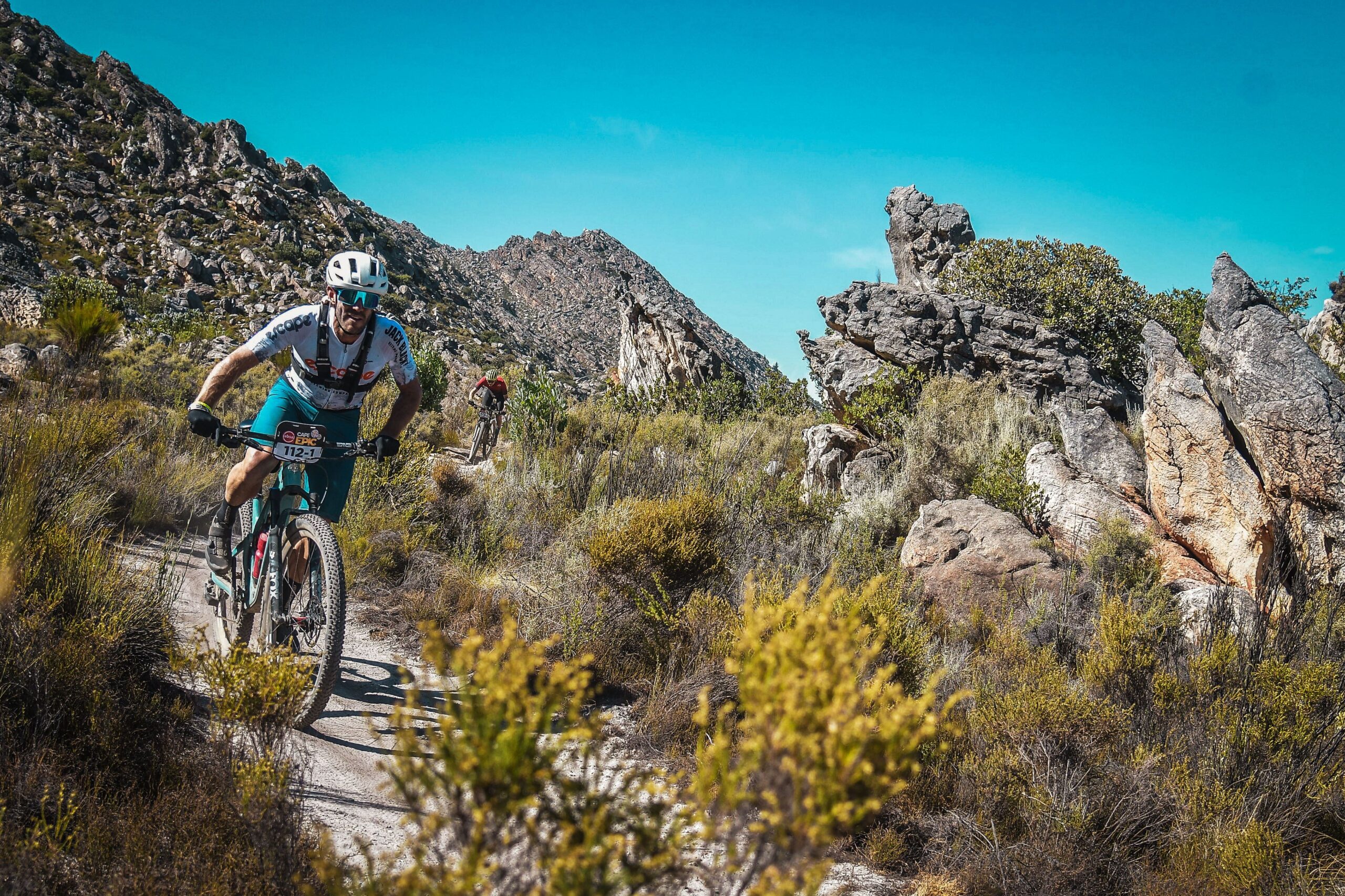
It was another day of feeling like the sun was out to murder us but luckily I was feeling good and thankfully, Pete suffers at a steady pace so we were moving well. At 80 km the Wagon Trail was our exit from the valley and we dropped towards the finish line at Saronsberg. The final 8 km white-knuckle descent and 10 km of fast farm roads perked Pete right up. He found his legs and we galloped home, pausing briefly to observe Grand Masters podium contenders Abraao Azevedo and Peter Vesel dink each other to the line.
A few hours earlier, backmarkers who had started in the later batches were diving out of the way of leading pro teams bombing past on their way down the Wagon Trail. A serious miscalculation by organisers. Not good. The maximum stage time was quickly pushed out to 9 hours and 40 minutes, as they realised the route bungle held up the riders who could least afford it.
If the Saronsberg camp after stage 1 looked like a field hospital, stage 2’s aftermath was worse. Bodies were bruised and battered and countless stories of mechanical disasters and painful crashes were traded in the cavernous dining marquee at the evening’s prizegiving.
Our time: 5:47 (23rd in Masters, 124th overall)
Elite men’s winners: Buff Megamo (Hans Becking/Wout Alleman) 4:05
Elite women’s winners: Ghost Factory (Nicole Koller/Anne Terpstra) 5:11
Masters winners: Bulls Masters (Karl Platt/Tomas Misser) 4:35
Stage 3: Moving house
94 km | 2,100 m
We were back in B-batch, baby! I was wrong about the C-batchers. These B-batchers were definitely our people. But there was added pressure for stage 3 (day four) as it was a moving day and we had to eat, dress, pack up all our gear, fetch our bikes and be ready at the start line by 7.20am. The 94 km route from Saronsberg to the quaint farming town of Wellington awaited.
There was nothing quaint about the route to get there. A rugged test of technical climbing (and trackstanding again!) led us through the Waterval Nature Reserve, Zuurvlakte, and Kluitjieskraal climbs inside the first 30 km. Just staying upright and pedalling saved time and Pete and I were again among the few riders around us who consistently rode up the trails. Passing walking riders while still pedalling is satisfying.
After wildfires only a month prior it was a spectacular but merciless moonscape all morning. Blackened, eroded and unrelenting jeep track up and down turned to thick sand then smooth asphalt up the recently resurfaced Bainskloof Pass. It was hitting 40°C (104 ºF), we were struggling, and we had our first partners’ spat after I towed a bunch of riders away from Pete down the mountain pass. I apologised for being a dick as we reached the final singletrack trails of the day. The aptly-named Cheesegrater climb shredded our resolve just 12 km from our new race village home. We soldiered to the finish, dreaming of the cold beers in my dad’s hands.

Day four done. We’d reached the halfway point in the race and the post-race ritual continued. Collapse, hydrate, eat, shower then nap under a misting fan. We awoke in the afternoon to whispers that the following day’s ‘Queen Stage’ had been shortened due to the inescapable heat.
I was quietly happy about the decision. I was grappling with my own guilt. Pete was having a very different experience to me. He had been to some dark places that I hadn’t visited in the opening four days. It’s just the way it goes. Sometimes you’re the hammer, sometimes you’re the nail. I was inadvertently the hammer all week. I felt bad about it. On paper, Pete and I are well-matched. I am genuinely in awe of his fitness and climbing skills. He runs 160 km in a weekend and is back on the tennis court on Monday. I’ve never run over 35 km.
Pete was moving well – we were inside the top 25% of the field – but he hadn’t found his rhythm and wasn’t having fun. He knew it too and apologised, though I could see he was digging as deep as possible. My guilt came from feeling great and enjoying myself out there. Glancing across at Pete’s hunched shoulders I knew he wasn’t. I had been in his position many times. We all have. It’s one of the worst experiences in the sport – the idea that you are holding someone back from riding at a faster pace.
I didn’t want Pete’s Epic experience to be defined by suffering or the feeling that he was letting me down. He wasn’t. I was riding my bike. With my best mate. On a weekday. We were fit. We were healthy. I was loving it. I tried to lighten his load that day – sitting in the wind, leading on climbs, pushing him up jeep track and letting him set our pace. It’s hard to say if my chatting, pushing, words of encouragement or yelps of singletrack joy were helpful or annoying, but they were the best tools I had.
Our time: 4:55 (21st in Masters, 104th overall)
Elite men’s winners: Canyon Sidi (Andreas Seewald/Marc Stutzman) 3:40
Elite women’s winners: Ghost Factory (Nicole Koller/Anne Terpstra) 4:31
Masters winners: Bulls Masters (Karl Platt/Tomas Misser) 4:06
Stage 4: The cliffhanger
73 km | 2,550 m
The reduced Queen Stage was a procession of testing climbs ramping in intensity alongside soaring temperatures. It just didn’t end. We inched our way up the first three ascents trying to save something for the climb nicknamed Aap d’Huez and the revered Cliffhanger switchbacks at the end. Stunning, twisty singletrack sections didn’t last long enough to restore our spirits before the next slog started. Shady pine plantations led to towering gums and finally exposed fynbos scrub. We stopped a few times to gather ourselves for the next push upwards. On the final climb as Pete and I zigzagged to the summit of Cliffhanger, barely making each switchback turn, a bunny-eared mirage appeared …
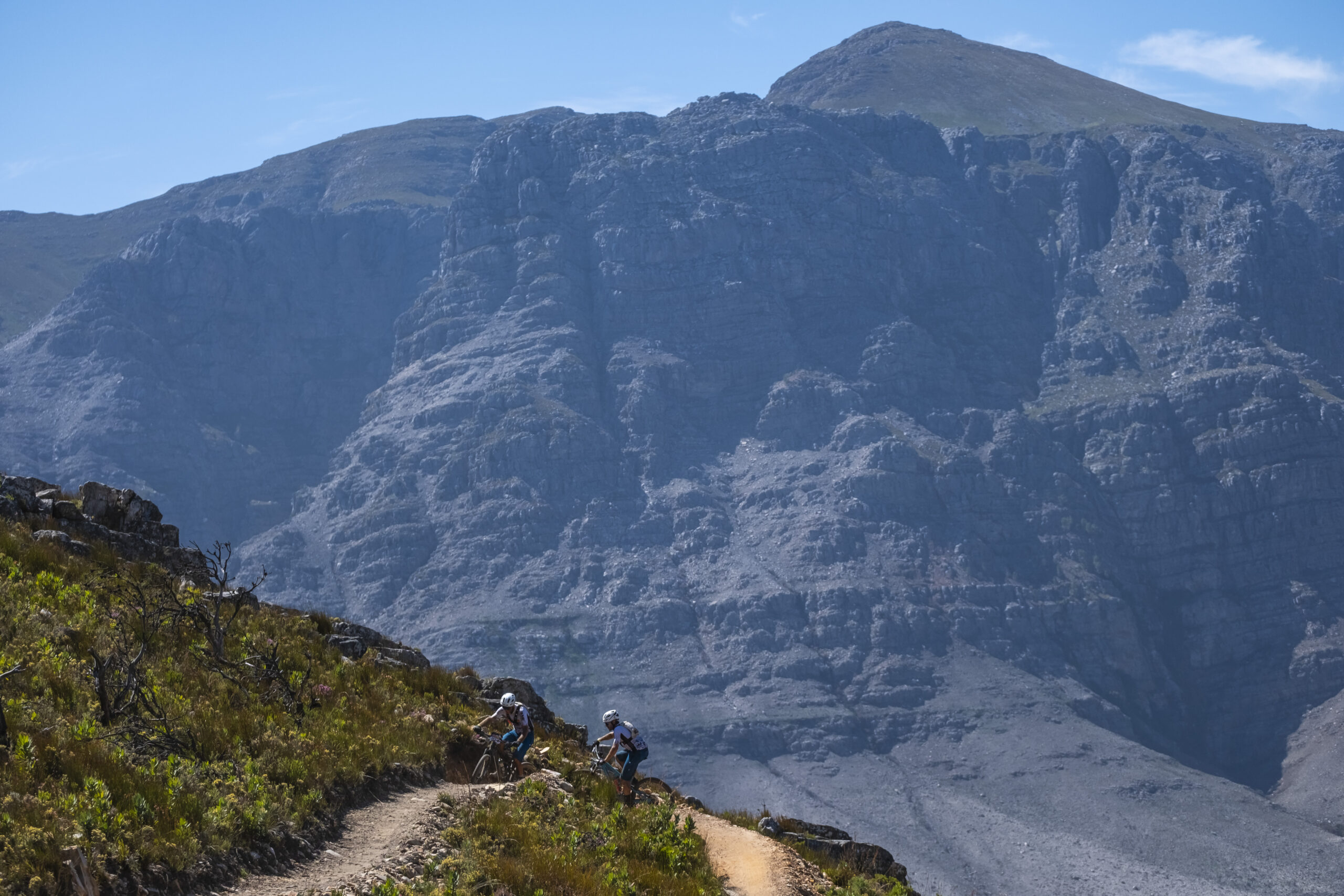
Our friend Harry, wearing a bunny mask, and his wife Michelle were camped on a mountaintop cheering us on every leg-sapping 180° turn. Beer-in-hand Harry bounded up the track yelling at us, “Come and get it”. I wasn’t sure if Harry was real, or whether the heat had Pete and I hallucinating. At the sight of Harry, Pete’s back straightened, his legs tightened and he powered on up after the rabbit. We were suddenly hauling! At the top, as we each took a sip of a deliciously lukewarm beer, we were deeply grateful that friends had made the trek to support us trailside.
What greeted us on the other side was a descent to the finish line that is hard to describe. Unmitigated beauty and expertly crafted trails. A sheer switchback drop that felt like it was suspended in mid-air, with turns stacked on top of each other like pancakes. We felt like fighter pilots on a training drill. The Cliffhanger and the serpentine forest roller coaster that opened up below it are some of the finest trails I have ridden anywhere.
Stage 4 was the most complete Epic stage I have ever experienced. Raw, tough, unrelenting but so rewarding. We crossed the line in Wellington hot and spent, packing ice cold face cloths and handfuls of ice inside our jerseys (and bibshorts), trying to return our bodies to normal operating temperatures. We replayed the day’s route with new and old friends as we sprawled out under the stretch tent. Pete and I wondered aloud to each other how those further back in the pack would cope with the heat and the towering climbs.
We came back to the start-finish line in the late afternoon to cheer the last riders across the line and the answer to our question was written in dust-etched faces. It wasn’t just us – stage 4 had knocked the stuffing out of everyone. Only 516 of the original 727 teams remained in the race.
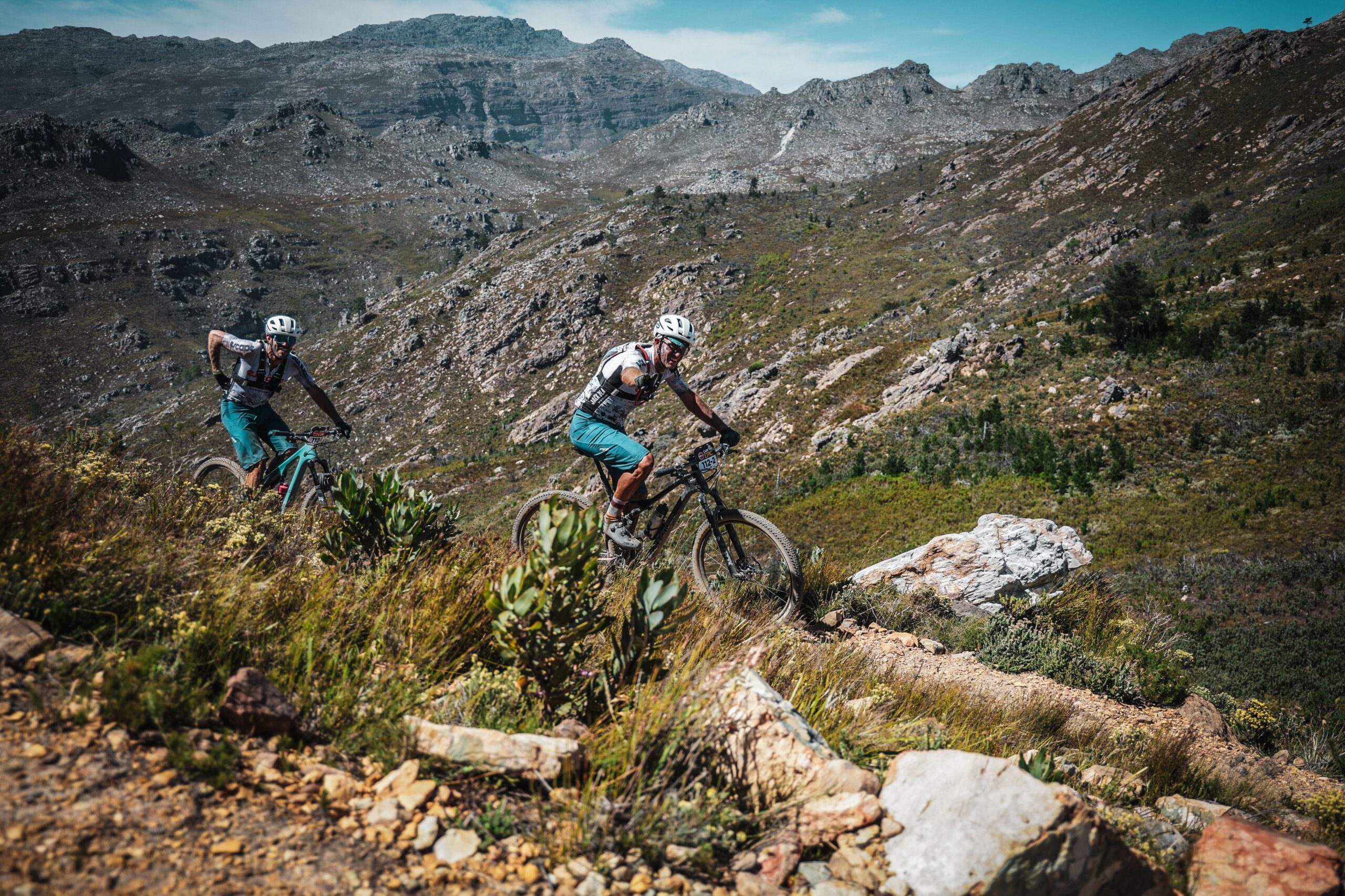
Our time: 4:59 (22nd in Masters, 119th overall)
Elite men’s winners: World Bicycle Relief (Nino Schurter/Sebastian Fini) 3:22
Elite women’s winners: Ghost Factory (Nicole Koller/Anne Terpstra) 4:08
Masters winners: Bulls Masters (Karl Platt/Tomas Misser) 3:56
Stage 5: What happened?
70 km | 1,750 m
Epic riders had been slowly roasted alive over the previous five days so the prospect of riding stage 5, with ‘only’ 1,750 m of vertical ascent in cooler weather (26 ºC / 79 ºF) was a godsend. Strangely I’ve drawn a complete blank on all memories of stage 5 despite looking at photos and reviewing the route. Nada. Maybe the emotional highs and lows of stage 4 stole my bandwidth. I remember Pete and I rolling off our chairs laughing over breakfast for no particular reason. But that’s it. Photographic evidence suggests I had fun on the trails, and I know the trail network well; it was a genuinely enthralling route. That said, I can’t recall a single notable moment from our five-hour, 70 km jaunt around Wellington.
My dad drove us from Wellington to Stellenbosch after stage 5 for the final two stages. By this stage he was a well-recognised figure in the race village. He was the only bare-chested, 76-year-old soigneur, wearing nothing but a necklace and a sarong at the finish line. It’s unfortunate but not surprising that a photographer momentarily mistook him for a homeless person.
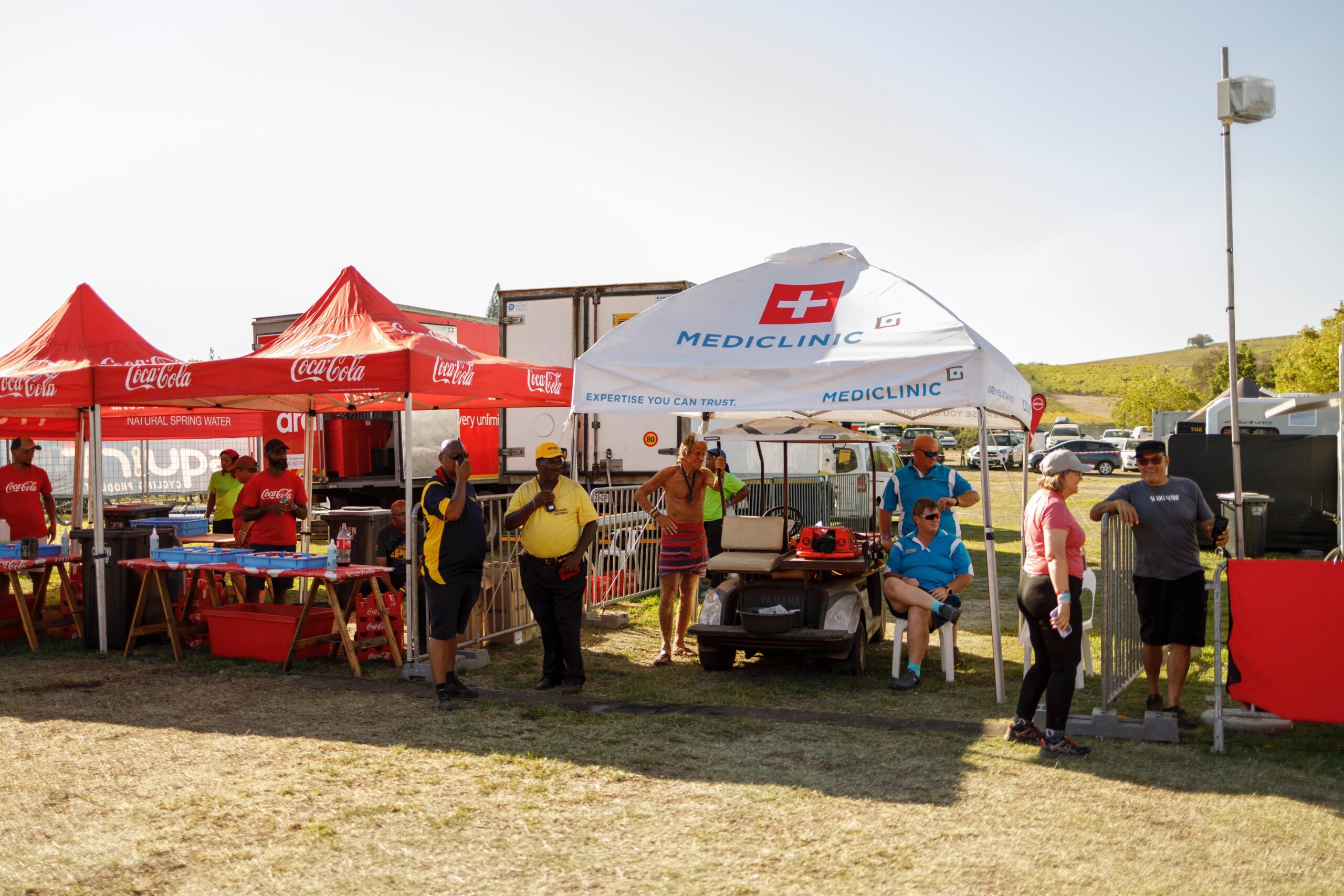
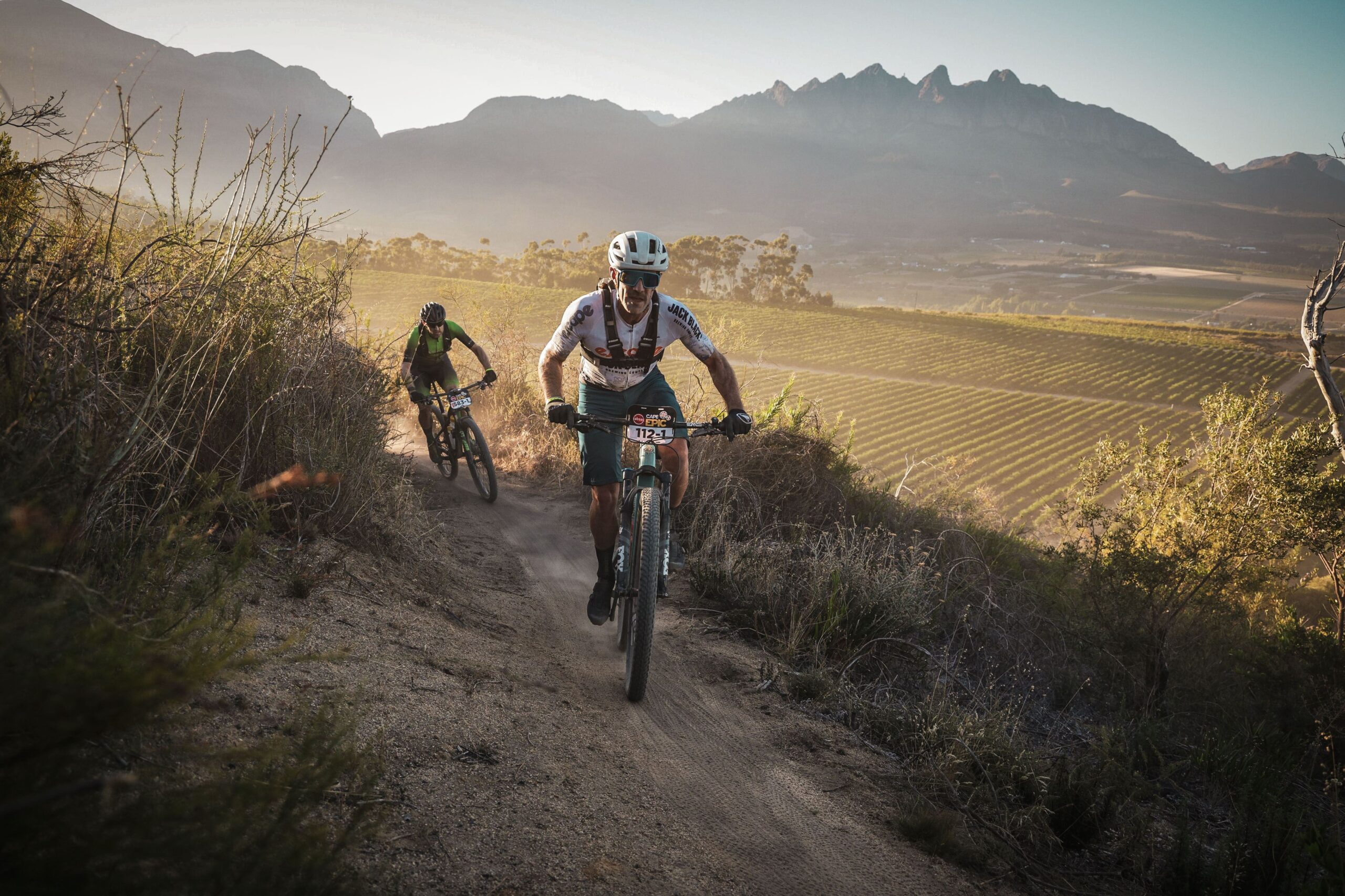
We were stoked to be unpacking our gear in Stellenbosch in cooler temperatures. We treated our bikes to their first professional service of the race, foregoing our sunset ritual of washing, lubing, and bolt-checking over a few beers. I was happy to hand it over to a professional mechanic – a fork service is beyond my skillset. The daily dust had wreaked havoc on our suspension forks, getting under the seals and making them unresponsive. It was hard enough to hold onto our handlebars through the demands of so much technical riding. It was pure torture when the fork was sticky and harsh.
Our time: 3:46 (24th in Masters, 111th overall)
Elite men’s winners: Toyota Specialized Ninety One (Matt Beers/Howard Grotts) 2:46
Elite women’s winners: Ghost Factory (Nicole Koller/Anne Terpstra) 3:21
Masters winners: Unimed Fourlab (Thiago Machado/Claudio Altivo) 3:08
Stage 6: In the shadow of Simonsberg
87 km | 2,400 m
On Saturday we woke to overcast skies and light rain for the first time in the race. A sense of relief emanated from the race village. Stage 6’s sawtooth profile around the iconic Simonsberg mountain was 87 km of twisting, lush dirt through hand-built trails linking some of the region’s oldest wine estates – Rustenberg, Quoin Rock, Mauratie, Uitkyk, Knorrhoek, and Morgenhof. Overnight showers had transformed the dust bath of the previous six days into a feast of grippy and fast-rolling pathways – hero dirt – and gave us another day to marvel at the skill of local trail builders. It’s hard to explain the joy of riding hand-hewn trails. Weaving through vineyards and indigenous forests. Rolling over rock formations and slicing through hillsides. Done right it’s like being on a magic carpet ride.
Pete and I were grateful that the day’s climbs and rewarding descents were spread evenly throughout the day, allowing us to better manage our pace on tired legs. Pete was hurting, tapping into his deep reservoir of resilience. It was the weekend, and family and friends had trekked out to Stellenbosch to watch. Hearing our names shouted back at us everywhere was such sweet motivation to our flagging bodies, although it was hard to look up from the trail to see exactly who was supporting us as we bombed down a switchback or ripped through a tunnel of spectators at a waterpoint.
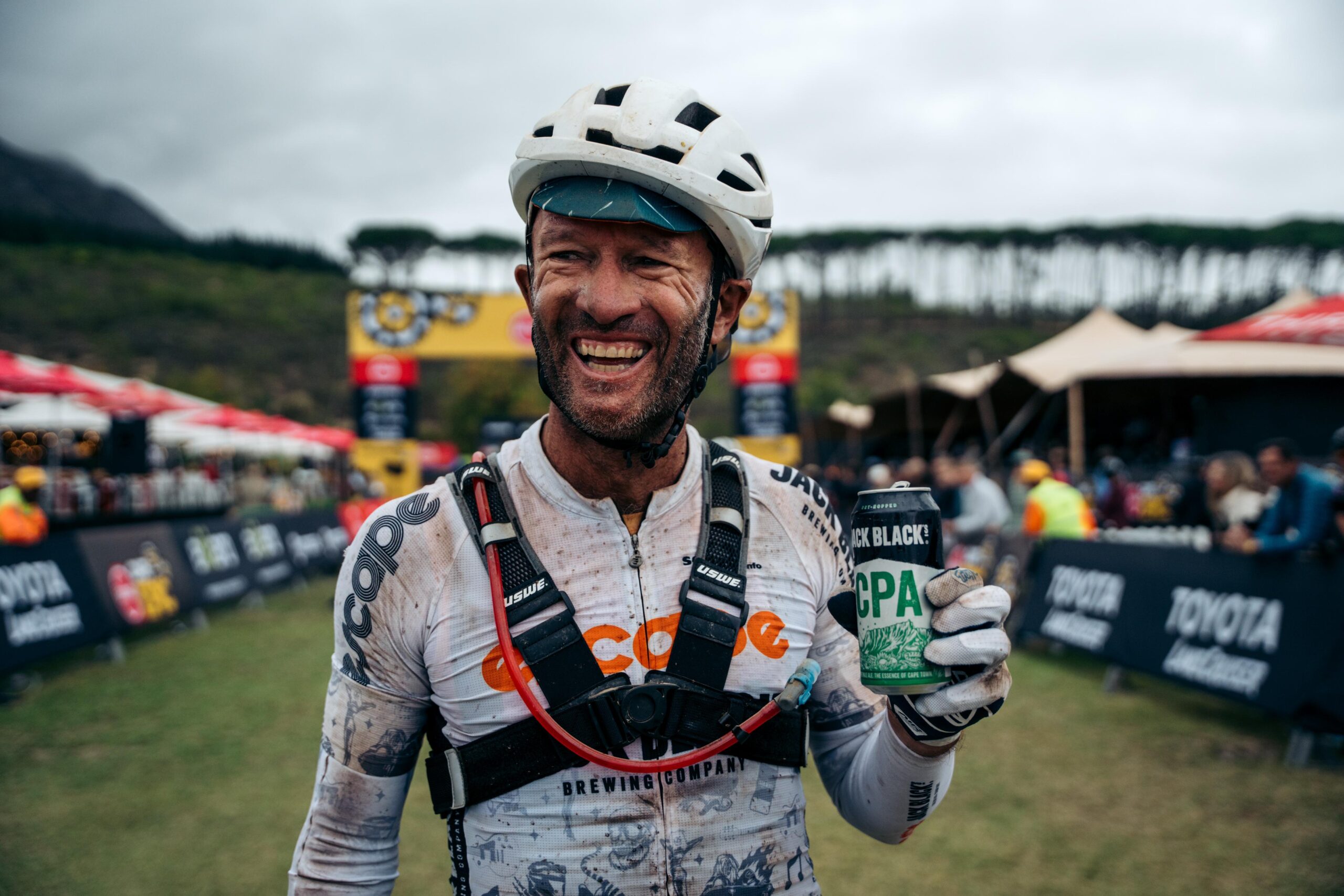
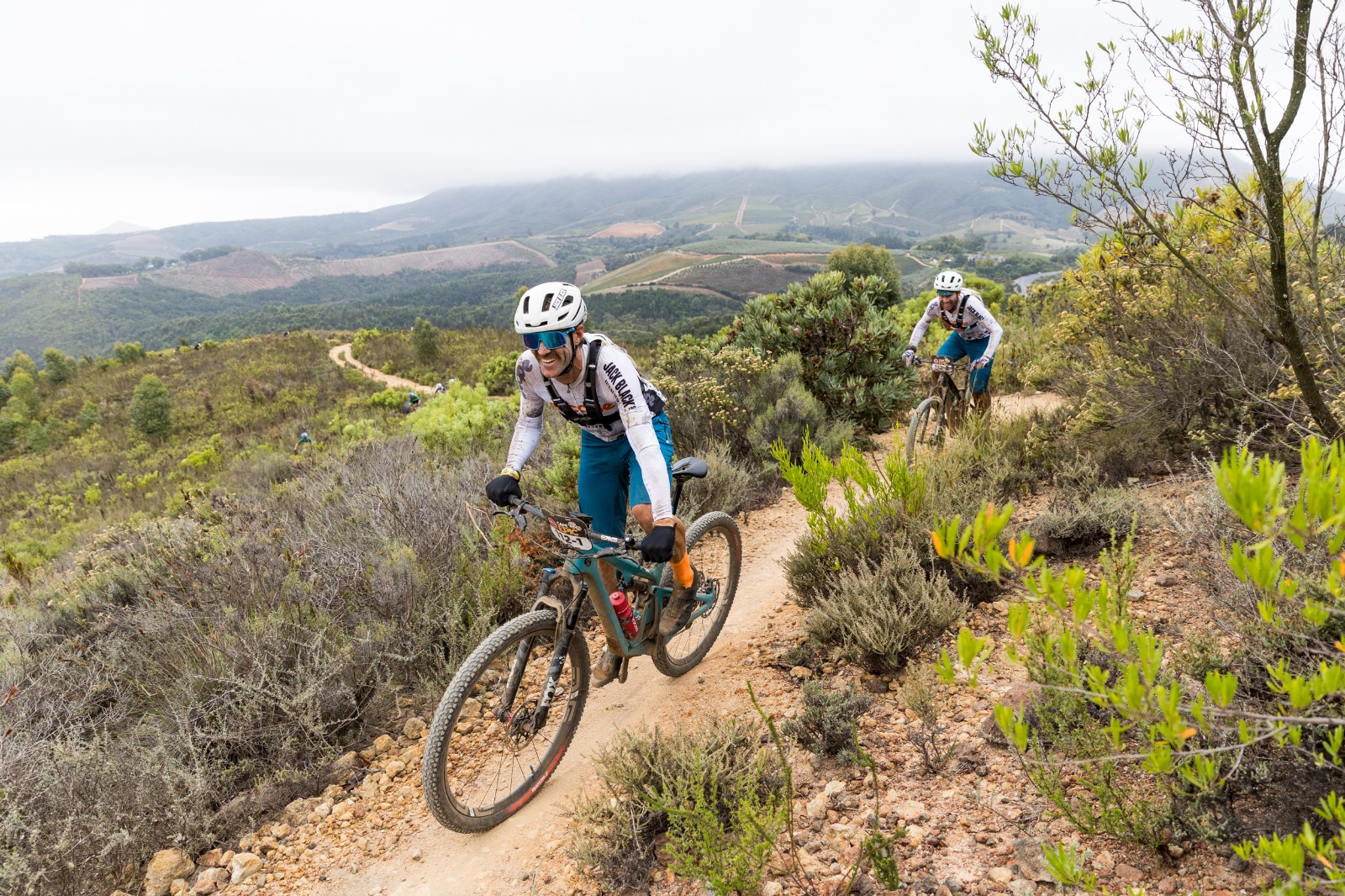
As we neared the penultimate finish we started to breathe easier. The finish line was in sight.
We’d avoided major mechanical failures and kept the bikes mostly upright and therefore our bodies relatively unharmed. We’d survived the worst of it. We weren’t there yet, but we could start to believe we’d make it.
Our time: 5:06 (22nd in Masters, 107th overall)
Elite men’s winners: Toyota Specialized Ninety One (Matt Beers/Howard Grotts) 3:46
Elite women’s winners: Ghost Factory (Nicole Koller/Anne Terpstra) 4:30
Masters winners: Bulls Masters (Karl Platt/Tomas Misser) 4:15
Stage 7: Sending it in Stellenbosch
67 km | 2,000 m
Stage 7 and our bodies were at their limit. I had a general ache that started at my neck and extended to my toes. One more day. The exhilarating 67 km through arguably the most famous trail network in the Western Cape, Jonkershoek, felt like a trip to an amusement park.
Thankfully, the start was not as fast as those earlier in the week but it was the same chaos – riders moshing about in the bunch, trying to find their rhythm and their partners. Pete and I settled into the first 15 km of climbing on open roads and then jeep track as we marched into Jonkershoek. We were riding as fast as our tired legs would allow, anxiously trying to hold our position. Squeezing 1,000 riders of differing skill levels into the never-ending singletrack Nirvana in the nature reserve meant bottlenecks as soon as the route narrowed and the fun stuff started. Riders we knew we’d fly past on the technical trails were schooling us on the climbs! But we had to let them go.
Pete and I caught ourselves cursing the same Colombian guy who had effortlessly passed us uphill, climbing like scalded, throughout the week. He easily beat us into the singletrack but when the trail pointed downhill he cautiously picked his way through technical sections at walking pace, with riders queueing up behind him. Being held up in familiar high-speed trails was frustrating and briefly hijacked our entertainment.
It didn’t last long as more flowing trails opened up into one another and the kilometres flew by. It was a fast and fun way to celebrate the end of our Epic journey.
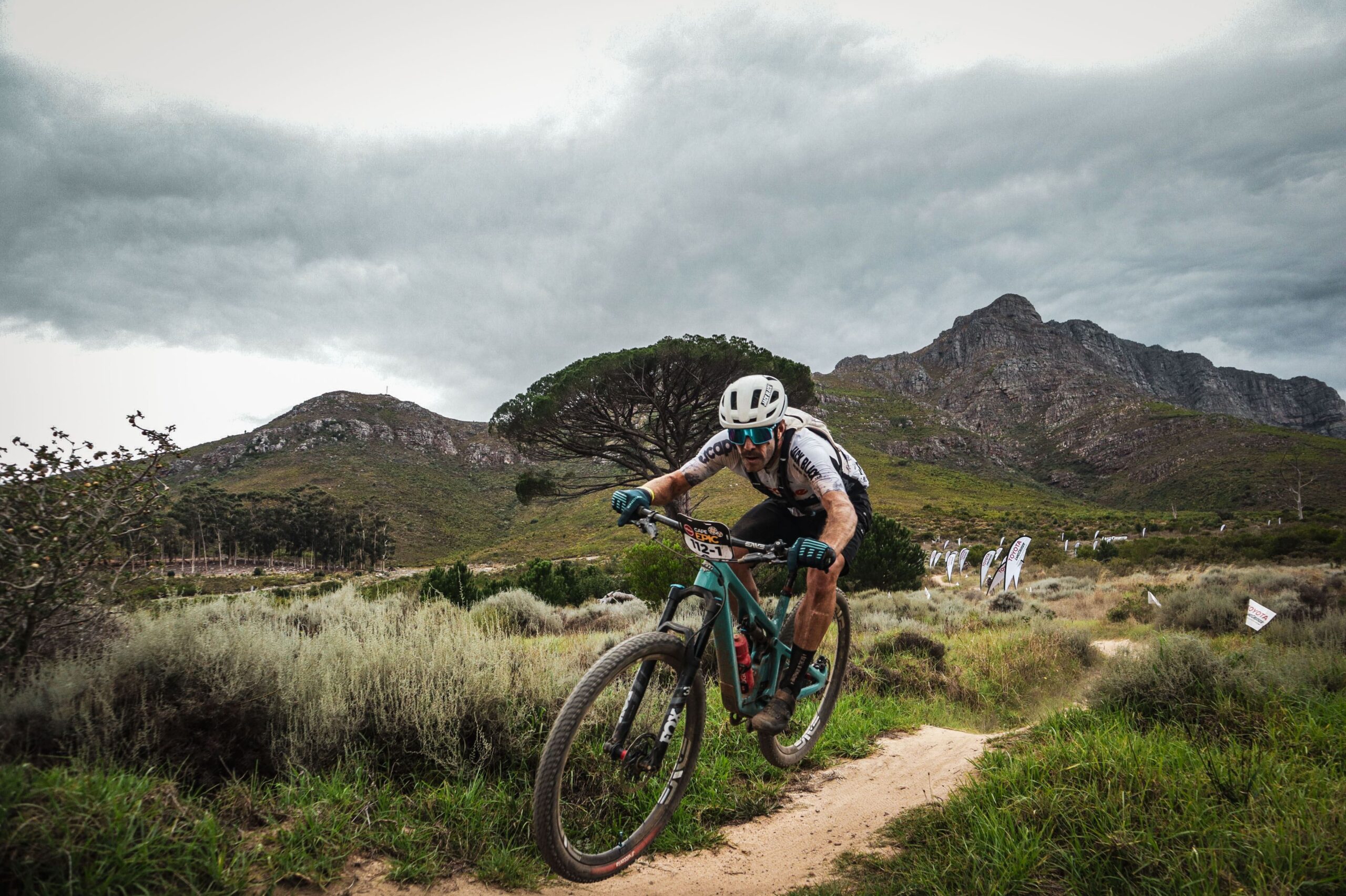
As we crossed the final finish line and shared that final beer, I was overwhelmed with gratitude towards Pete. We’d nailed it. With each pedal stroke we had discovered more about the intimate dance of teamwork on two wheels. We had created a story together.
106th overall (25th in Masters) on two months training. I am proud of that. We even won the baggies category.
Yet the final stage was bittersweet. Charging through technical trails is what I live for but I wanted to slow it all down. Riding bikes at this level of intensity for eight days is gruelling but it’s also a break from the routine of daily life. I have found that the beginning of the race is a process of extricating my mind from all the things I have left behind, trying to be present. By day five I have forgotten that I have a life outside my canvas tent, my carbon saddle, and the dining marquee. Heading for the finish line I was straddling two worlds again, knowing the Epic bubble would burst and normal life would resume.
I had an epiphany in the closing kilometres of the final stage. Some part of who I am requires extreme physical exertion to bring me face to face with the gift of my life and my body. I am truly happy here and now. Riding thrilling trails with great company for days on end. Testing the outer limits of endurance. Everything hurts but I feel alive.
Our time: 3:56 (18th in Masters, 94th Overall)
Elite men’s winners: Bulls Mavericks (Simon Schneller/Urs Huber) 2:52
Elite women’s winners: Ghost Factory (Nicole Koller/Anne Terpstra) 3:32
Masters winners: Bulls Masters (Karl Platt/Tomas Misser) 3:25
So how hard was the 2024 Cape Epic?
The Epic bills itself as the ‘Tour de France of mountain biking’ and most cyclists have some appreciation for how tough the three-week summer road tour is. But amateur riders will never get to experience the Tour from the saddle. Yes, we can ride the route and summit the iconic Alpine and Pyrenean passes, but we’ll never have a racing experience of it.
The Tour consists of 22 teams of eight for a total of 176 riders, all professionals. The 2024 Cape Epic featured 55 UCI-registered men’s teams and 19 UCI-registered women’s teams (many of whom are not full-time professional cyclists). An additional 1,306 amateur riders tackled this year’s Epic.
The ProAm nature of the Epic is its drawcard for us mortals. Every rock, every climb, every corner that Olympic and multiple-time world champion Nino Schurter rode at the 2024 Cape Epic was navigated by every single one of the official finishers. We shared the same finish line welcome as Mona Mitterwallner, the reigning MTB Marathon world champ. There is a powerful sense of accomplishment in knowing that.
It’s also what makes it so damn tough. While the leading men’s team Toyota-Specialized-Ninety One (Matt Beers and Howard Grotts) spent 25 hours and 22 minutes racing the 2024 Epic and the Ghost Factory women (Nicole Koller and Anne Terpstra) took 30 hours and 56 minutes, the slowest team after eight days was the Spanish and Mexican Masters pairing of Bittor Ilardia and Gustavo Cardenas. They were on course for a mind-numbing 57 hours and 10 minutes.
I caught up with Daryl Impey after the Epic for his take. Daryl is a Tour de France stage winner and South Africa’s only wearer of the Tour’s yellow jersey. He retired from pro racing last year and rode his first Epic this year with his mate, celebrity chef David Higgs. The pair raised over a million Rand (US$54,000) for Marang House, a local charity benefiting chronically sick kids, and documented their daily experiences on YouTube.
“It’s pretty grueling … I didn’t think [the Epic] was designed with the amateurs in mind,” he laughed. “Then again, it’s cool to ride the same course as Nino and those guys. It was challenging and different and caught me off guard, especially the first Toyota Tough [section] in the Prologue. I was really a bit [more] cautious then worried, but as you get through the week, you feel a bit better.
“I’ve spent my whole career at threshold, so I didn’t really want to do more racing, but wanted to experience it. It was awesome to do it mid-pack and film it to show people what the Epic actually is at the back. Nobody gets to see those images of a guy jumping in a pool in his kit and his helmet. Nobody gets to see the images of other people suffering or having a boerewors [local sausage] roll on the side of the road … all those kinds of things. I think it makes it special.
“I got asked this question a lot, like what’s harder? A stage in the Tour or whatever? I can’t really comment on it because I wasn’t racing [the Epic]. You can’t say one’s harder than the other because, number one, the duration is different. It’s just a different style of racing, riding.”
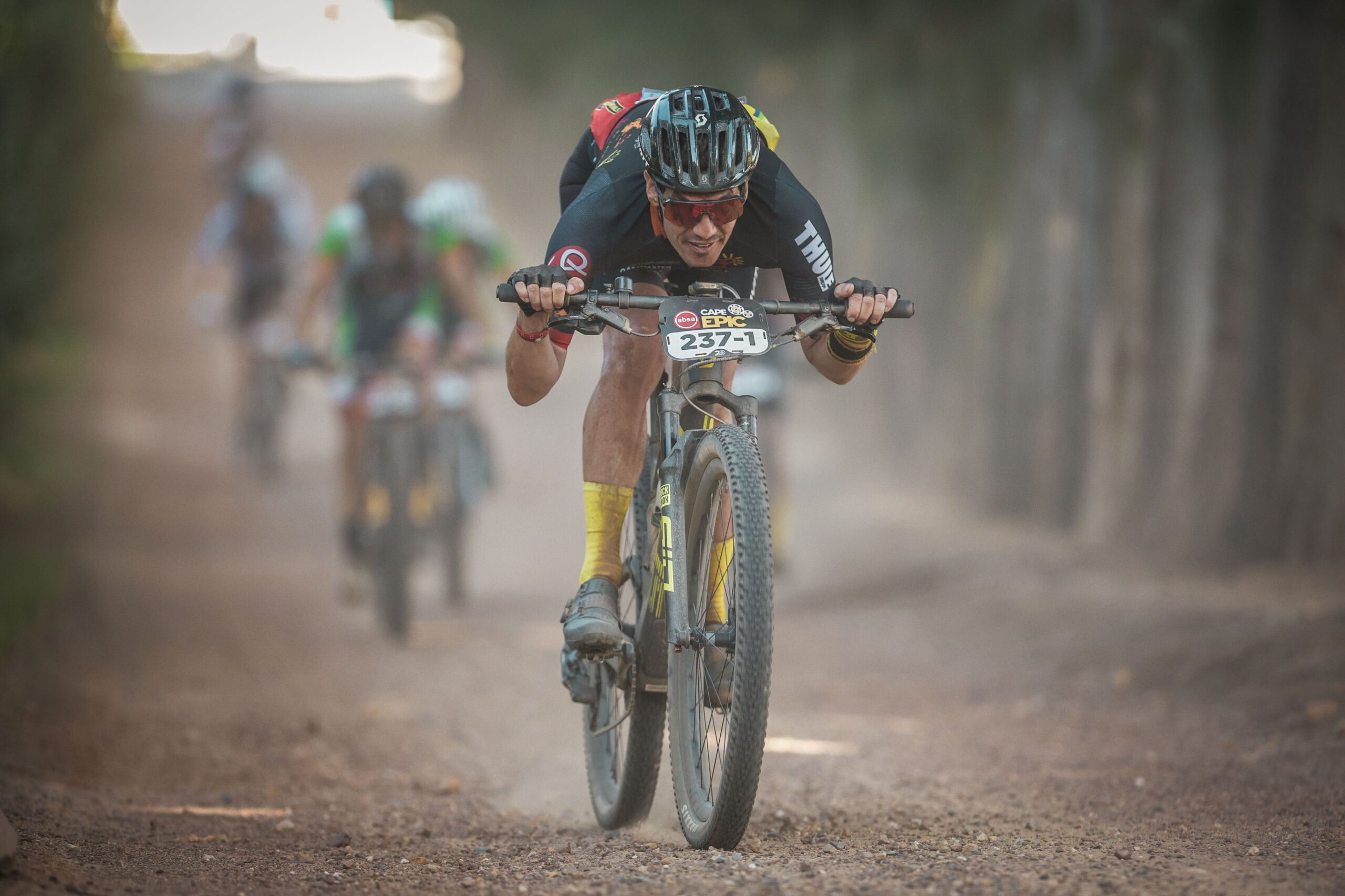
With 12 finishes from 12 starts, and five different partners I’ve got a decent perspective on the progression of the Cape Epic and whether it is getting harder.
It was a different event in 2006, when I first rode with my brother, Simon. It wasn’t the slick, corporate-branded machine it is today. We rode 940 km from Knysna to Stellenbosch, stopping for a single night in each host town. It was like a traveling bike circus. Everyone was in cramped red tents, where getting dressed in the morning required yogi-level dexterity. If it rained, riders were better off zipping themselves into their own kit bags to stay dry. Thankfully, 2024’s new larger canvas tents were a revelation.
In the early years, it was a wild adventure with remote trails connected by endless corrugated gravel roads. There was far less technical riding and you could look up more to appreciate the spectacular scenery around you. There were times when Simon and I felt completely isolated, like the only riders in the race. The two-person team format was in place for safety reasons as we traversed far-flung corners of South Africa’s hostile Western Cape landscape en route to Stellenbosch.
From 2009 onwards the race spent multiple days in each location. Centralised race villages allowed access to the proliferation of world-class trails springing up in the Western and Southern Cape. The race’s reputation meant more trail-builders were working their magic in the area, as mountain bike tourism, and the industry in general, boomed. Route designers didn’t have to link singletrack sections with long gravel road transitions anymore. The Epic transformed into a densely packed thrill ride. Overall, the mountain biking experience is better for it. Although the nostalgia of point-to-point touring is a loss.
As noted, the 2024 edition was the shortest Epic in total distance at 603 km, and featured the most climbing per kilometre of any previous Epic – 25 m/km. By comparison, the Epic’s first five years, from 2004 to 2008, averaged just under 19 m/km of climbing. The flipside of this is that per-kilometre-descending has also increased. Meanwhile, the average total distance has fallen from 895 km (2004-2008) to 730 km (2009-2013) to 690 km (2014-2018) to 630 km over the past five years.
This means more technical riding bang for your buck. But it has other implications. More technical riding, more climbing, and more descending makes staying adequately fueled harder. There’s less opportunity to reach for a bidon or dig in a jersey pocket for a gel or energy bar. It’s why hydration packs have made such a big comeback at the race. It also increases the likelihood of crashes and adds to overall fatigue. Technical descending requires concentration and can be as energy-sapping as climbing.
There was nowhere to recover in the 2024 Epic. It felt like we were either out of the saddle weaving through tight singletrack, straining against gravity, or flexing our forearms and fingers descending.
Despite organisers’ shortening 2024’s stage 4 by 15 km and 450 m of climbing, the event had the highest drop-out rate in the race’s history. Almost a third of the 727 teams who signed up didn’t reach Stellenbosch. If they hadn’t shortened the Queen Stage, this would likely have been higher. It’s impossible to say why this number was so high in 2024, but a combination of extreme heat, plenty of big climbing days, and highly technical trails was a trifecta working against the teams who weren’t properly prepared or who succumbed to crashes or illness (the dreaded ‘Epic belly’), or both.
In short, 2024 was a particularly tough edition. Certainly tougher than the earliest years, if for different reasons. If you were among the 488 teams who crossed the finish line together in Stellenbosch on March 24, you earned that finisher’s medal.
The Epic tests every aspect of mountain biking – power, fitness, pedaling efficiency, bike-handling. It also requires trailside mechanical skills. There are no follow vehicles. The Epic tests the softer stuff too – perseverance, presence, compassion, mental strength, and team work. These are harder to build into a training programme and their value only reveals itself when the going gets tough. It is possible to complete the Epic without calling on these traits but I’d argue the essence of the Epic is to surrender and explore yourself and your partnership.
And yet these physical and emotional qualities are not enough to wage an Epic campaign. The Epic crucible can melt the toughest individual and dissolve the tightest partnership with a random mishap or unexplained illness. The race can be cruel. Mastering blind luck is also needed. In short, Cape Epic rewards the complete package.
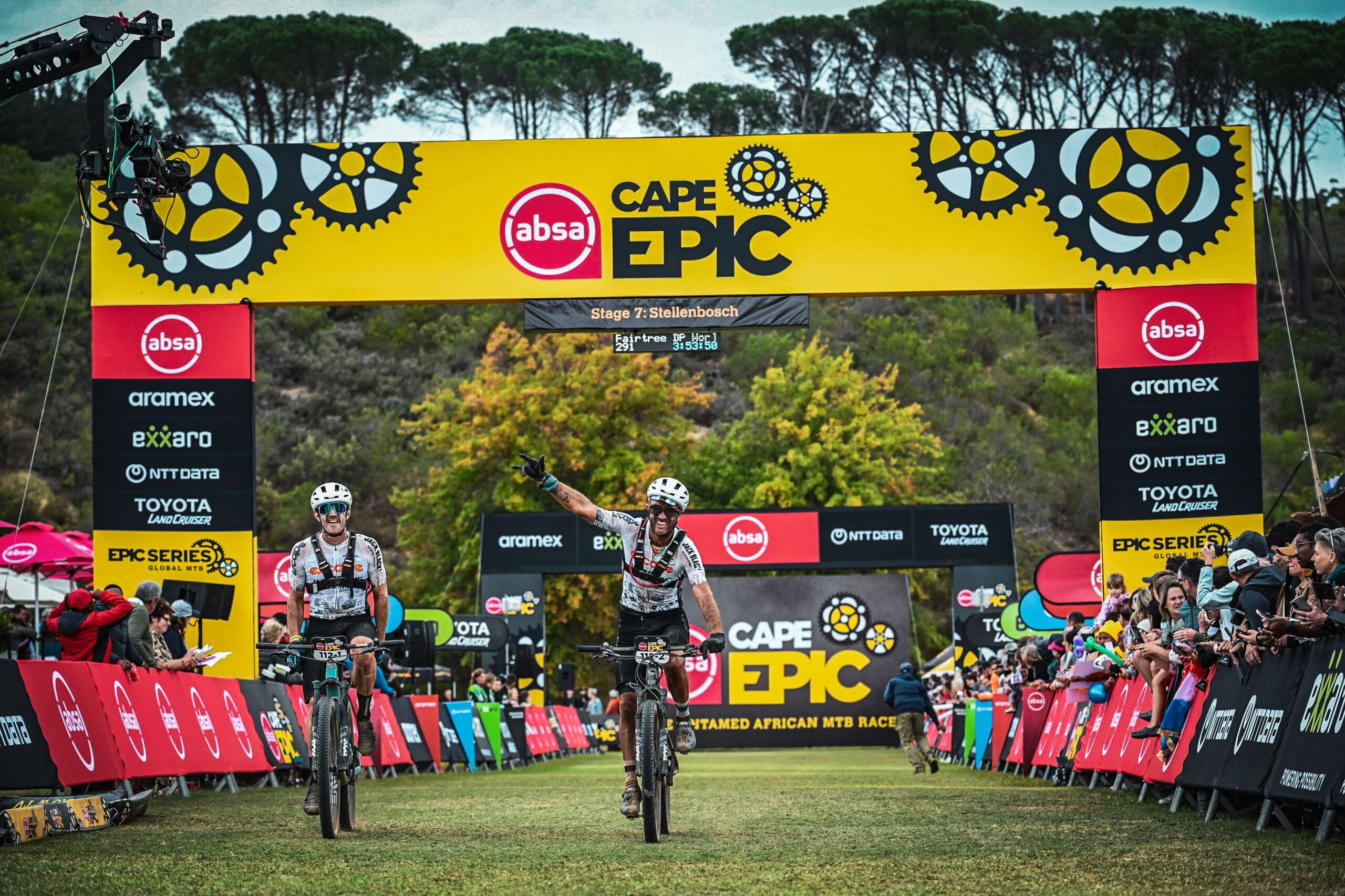
Did we do a good job with this story?

